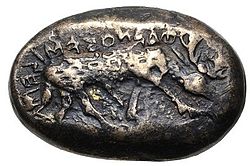Temple of Artemis

The Temple of Artemis (Greek: Ἀρτεμίσιον or Latin: Artemisium), was a temple dedicated to the goddess Artemis. It was also known as the Temple of Diana (Diana was a Roman goddess).
It was completed around 350 BC at Ephesus (in present-day Turkey). The area was under the Achaemenid dynasty of the Persian Empire, but some of its cities were Greek. Only ruins of the temple remain. It was one of the Seven Wonders of the Ancient World.
Location
The Temple of Artemis was near the ancient city of Ephesus, about 50 km south from the modern port city of İzmir, in Turkey.
Architecture and art
Most of the description of the Temple of Artemis comes from Pliny, though there are different accounts that give different sizes.
Pliny said the temple was 115 meters long and 55 meters wide. He said it was made almost completely of marble. It was about three times as big as the Parthenon by area. The Temple has 127 Ionic-styled columns. Each is 17.5 meters in height.
The Temple of Artemis had many fine artworks. Bronze sculptures by famous Greek sculptors Polyclitus, Pheidias, Cresilas, and Phradmon were in the temple. Paintings and gilded columns of gold and silver were also in it. The sculptors often competed at creating the best sculpture. Many of these sculptures were of Amazons, who are said to have founded the city of Ephesus.
Pliny said that Scopas, who also worked on the Mausoleum of Mausollos, worked carved reliefs into the temple's columns.
Athenagoras of Athens names Endoeus, a student of Daedalus, as the sculptor of the main statue of Artemis in Ephesus.
Cult and influence
The Temple of Artemis was at a flourishing region. It was used as a religious institute. Merchants and travellers came to it from all over Asia Minor. The temple was influenced by many beliefs. It can be seen as a symbol of faith for many different peoples. The Ephesians worshiped Cybele. They joined many of their beliefs into the worship of Artemis. Artemisian Cybele became very different from the Roman goddess Diana. The cult of Artemis attracted thousands of worshipers from far-off lands. They all gathered at the site and worshipped her.
Temple Of Artemis Media
From the 1572 Octo Mundi Miracula, the earliest known representation of the temple in modern times. The hand-colored engraving was by Martin Heemskerck.
A drum from the base of a column from the 4th-century rebuilding, now in the British Museum
Reconstructive plan of Temple of Artemis at Ephesus according to John Turtle Wood (1877)
Traditional many-breasted interpretation in a 16th-century fountain of Diana Efesina, Villa d'Este, Tivoli, Italy
Farnese Artemis (2nd century) in the National Archaeological Museum, Naples (no. 6278)
References
- Anton Bammer, "A Peripteros" of the Geometric Period in the Artemision of Ephesus" Anatolian Studies 40 (1990), pp. 137–160.
- Lynn R. LiDonnici, "The Images of Artemis Ephesia and Greco-Roman Worship: A Reconsideration" The Harvard Theological Review 85.4 (October 1992), pp 389–415.
Other websites
- UnMuseum's The Temple of Artemis Archived 2006-10-10 at the Wayback Machine
- Seven Wonders' Temple of Artemis Archived 2005-09-30 at the Wayback Machine
- Florence Mary Bennett, Religious Cults Associated with the Amazons: (1912): Chapter III: Ephesian Artemis (text)
- James Grout: Temple of Artemis, part of the Encyclopædia Romana
- Diana's Temple at Ephesus (W. R. Lethaby, 1908)









